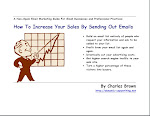Recently I've noticed a big increase in businesses contacting me to write white papers for them. I think it's no coincidence that these calls are coming my way during what looks to be a long and difficult economic downturn.
White papers are remarkable and effective selling tools that smart companies have been using for a long time, but when the economy gets rocky, they may be even more vital in bringing in new business.
Companies that offer a complex product or service, or solve complex problems, will particularly find that white papers can drive business their way . Most often companies using white papers for their marketing are in technical or engineering fields. But I am also seeing law firms, architectural firms, energy companies, consulting firms, medical equipment companies, pharmaceutical companies, lobbyists, manufacturers, banks and investment houses, and accounting firms using them.
But as diverse as these industries are, they all have one thing in common: They will have to compete even harder to attract new business in the coming economy. For them, and actually for any business, white papers are becoming an essential marketing tool.
Michael A. Steizner, the author of "Writing White Papers: How to Capture Readers and Keep Them Engaged," says that a good white paper reads like an informative magazine article, while at the same time it is a persuasive document. In other words, it is both highly readable and it sells by offering solutions to real problems the audience is experiencing.
One rule of thumb that has helped me when writing white papers is to remember that only about half of the readers will be technical people who speak the jargon of the field I am writing for. My job, therefore, is to make difficult concepts easy to understand for those non-technical people, without losing the technical audience in the process.
Some of the ways I have found to approach this balance are:
- Use case studies. Just as a good magazine article includes stories to illustrate what is being written about, case studies bring the problem and solution to life for the reader. Additionally, case studies add credibility and involve the reader emotional level.
- Focus on the problem your product or service solves, not the product or service itself. Readers, frankly, are not all that interested in you, your company or your wonderful gadgets until they can see what they will do for them.
- Emphasize, I really mean emphasize, benefits. Like all marketing documents, benefits are the be all and end all. Ask yourself, what will this widget do for the reader? What pain is the reader experiencing or what pain does the reader want to avoid? What does the reader want to gain? What will change for the reader if she solves this particular problem?
- Admit flaws. This may sound counter-intuitive, but admitting your product or service's limitations can be one of the biggest credibility boosters you can use. Especially if you admit the flaw in a way that it also sets up a powerful benefit. For example if you are a law firm that has a very narrow practice niche, telling what you don't do can be used to demonstrate that you do your one thing very, very well.
- Create a before and after scenario for the reader. Unlike a case study, which is a factual story about a real client, you can also write a story in which the reader is the main character. Complacency often rules the day because it is human nature to simply cope with a problem rather than solve it. So pour a little salt into the wound of the existing situation by reminding the reader of the cost and pain of the unresolved problem. Then paint a picture of the reader's company enjoying the benefits of your solution.
- Demonstrate the risk of not taking action. Paint a realistic picture of what will happen to the reader's company if things keep going the way they are now. While every product or service has a cost, most of the time there is an even bigger cost of NOT buying it. Make sure your reader is aware of this cost for inaction.
- Write to the reader as a person, not merely as a company. This simply means your white paper should be interesting, informative and easily understood. It also means this person will be taking on a personal risk if he makes the decision to buy from you. Take these personal needs into account.
- Provide useful, valuable information. Think of including elements of the white paper's more humble cousin, the tip sheet, in the body of your paper. Over and over again, I have found that white papers that have a section of frequently asked questions (FAQs) or bullet point lists of tips and ideas are the papers that get saved and passed along.
The best white papers focus on the interests and problems of readers. Alternatively, poorly-written papers merely focus on the products and services the company would like to sell, without concentrating on the customers' pain and needs.
Remember, for all the information you must convey in your white paper, in the end it is still a document designed to persuade and sell. And in this economy, it is even more important to keep this in mind.
COPYRIGHT © 2008, Charles Brown

Labels: case studies, lawyer marketing, white papers



0 comments:
Post a Comment